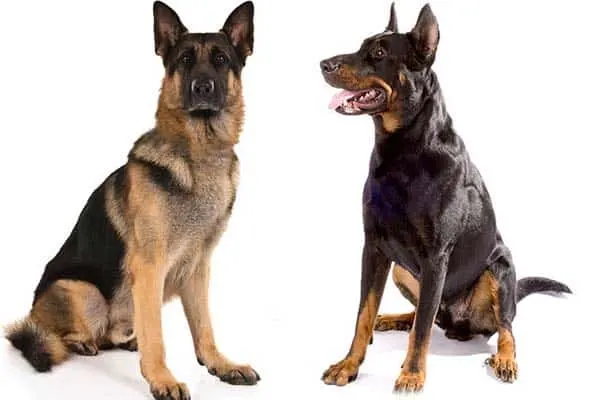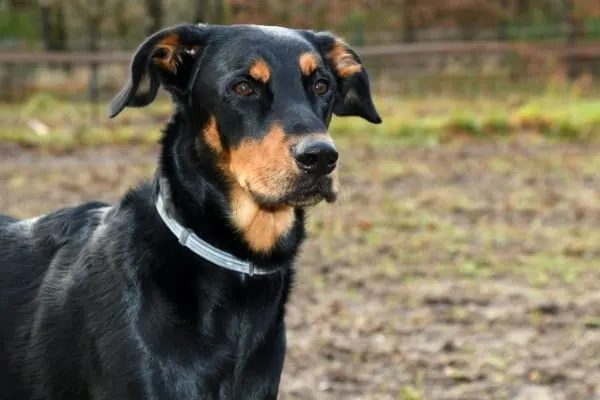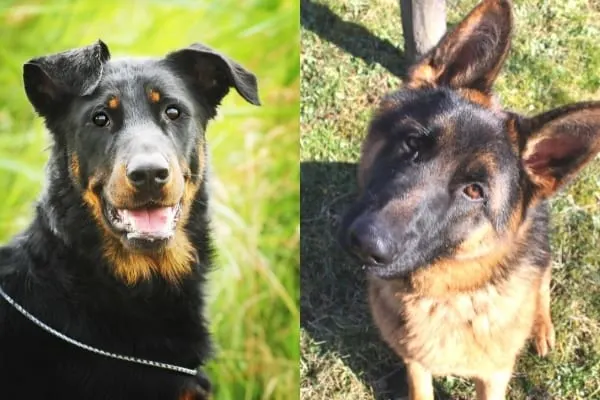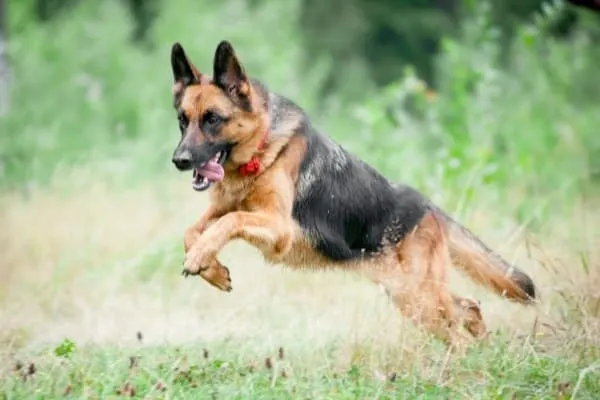German Shepherd vs Beauceron: How To Get the Better Dog For You
You are certainly familiar with border collies, Old English Sheepdogs, and Australian shepherds. The herding group draws us, perhaps because of the work ethic and intelligence of the class. Or maybe we just enjoy a herding dog’s good looks and intense personality.
Whatever the attraction, we often forget about particular breeds that are herding dogs. A few representatives of the herding class no longer even work with livestock.
Nevertheless, many of the traits that make a herding dog great are desirable in other areas of our lives. What if you have to choose between only two dogs? In the Beauceron vs German Shepherd contest, which dog comes out ahead?
A Beauceron is not a dog you see every day and maybe not one you have considered adding to your family. We compare a relatively rare breed versus one of the most popular dogs, the German Shepherd.
Familiarity with the Shepherd leaves a point of reference if you are in the dark about the Beauceron. Although similar in temperament and appearance, differences in appearance and companionship qualities may help you decide which is the better dog for you.

History Tells a Tale
The Alsatian, or German Shepherd, originated from a generic livestock-herding dog in Germany in the late 1890s.
Max von Stephanitz strove to develop a perfectly working machine through a show dog named Hektor Linksrhein who later became Horand von Grafrath.
According to the GSDCA, Horand and his sons, Beowulf and Hektor von Schwaben became the foundation sires of the modern German Shepherd breed.
Carefully orchestrated inbreeding and line-breeding produced a medium-large dog 22 to 26 inches tall at the shoulders and weighing 70 to 100 pounds or more.
German Shepherds have a dome-shaped head, a long square muzzle, large upright ears, a long neck, a sloping back, and a moderately long bushy tail.
A German Shepherd’s colors can range from black and tan or red and tan to solid tan, blue, red, or sable. Solid white, white markings or panda, and liver can also appear, but most registries disqualify dogs with these unusual colors.
Similar to the German Shepherd, the Beauceron was refined from a large family of herding dogs, but in France.
First recognized as a breed separate from the Briard in 1863, according to the Large Dog Breed Directory, Beaucerons may have influenced later working canines like the Doberman Pinscher.
A Beauceron, also known as a Bas Rouge or Berger de Beauce, resembles a Briard in personality and rear double dewclaws.
The Beauceron is taller than the Shepherd, ranging from 25 to 28 inches tall. Like the GSD, the Beauceron males are usually larger than the females.
The Beauceron’s head is somewhere between a Doberman’s and a Shepherd’s, well-chiseled without being fine.
The body is muscular, substantial, and balanced. Beaucerons have half-prick or hanging high-set ears, although often cropped where permissible.
Acceptable colors are black and rust like a Doberman, gray, black, and tan, or harlequin. Beaucerons have medium-short hair with a dense undercoat and fringes about the neck, backs of the hind legs, and tail.
How much exercise will your dog require?
Originally, GSD and Bas Rouge breeders bred their dogs for stamina. Both dogs can work tirelessly over dozens of acres and therefore require strenuous exercise every day.
Many people break exercise into a period of training, to exercise the mind and about 20 minutes of hard running. A leisurely walk around the block will not scratch the surface of what your dog needs to be happy and well-adjusted.
The two breeds are athletic and energetic. They move with efficiency and grace, with the German Shepherd able to reach speeds of 30 miles per hour. Beaucerons are only slightly slower.

What Does a Direct Comparison Look Like?
This video is not to encourage you to use a treadmill for your German Shepherd but to illustrate the dog’s efficient gait and stamina.
Other things to note are the classic black and tan coloration and pattern, upright ears, sloping back, long plush tail, and trainability. This Shepherd shows excellent fitness.
This video shows a Beauceron alternating between trotting, like the GSD above, and running. The Beauceron has a different way of moving than the Shepherd, displaying more of a spring than a glide.
Nevertheless, the Beauceron still displays fluid and efficient strides. Note the classic black and rust colors in the preferred pattern, the long tail, and natural ears.
Do You Need to Worry About the Weather?
Beaucerons and German Shepherds can tolerate temperatures as cold as 40 degrees Fahrenheit. We have seen GSDs content in conditions approaching the 20s, and Beaucerons can adapt to outdoor forays when temperatures are near freezing.
A large size helps limit the loss of body heat, and the Shepherd is more adapted to cold snaps than the Beauceron due to a denser undercoat. German Shepherds also tolerate warm weather better than Beaucerons, thanks to their undercoat.
Temperament and Personality Are Always Unpredictable.
Many personality traits are individual, affected by the environment as well as genetics. Therefore, it is sometimes difficult to make breed generalizations.
Dog-Learn reports that Beaucerons are less likely to bite but are more aggressive than German Shepherds.
If Beaucerons are more aggressive, how can it be they are less prone to attack? First, they are much rarer, ranked 130 in popularity relative to Shepherd’s No. 2 status.
Second, Beaucerons display more posturing threats before making contact, similar to the Doberman. Both Beaucerons and GSDs tend to nip, nudge, and prod, true to their herding origins.
Beaucerons and German Shepherds are friendly and protective around children in their families. They are too large and exuberant to trust alone with infants or toddlers.
If raised in a social atmosphere, as they should be, Beaucerons and GSDs will both be initially wary towards strangers but gradually warm to a politely aloof to friendly demeanor.
Beaucerons are more social than German Shepherds with individual differences. The Beauceron also is more attuned to her owner around guests, and her behavior will reflect your energy.
German Shepherds and Beaucerons are territorial and have well-developed guard instincts. They make fierce protectors of people and premises but can also have issues with dominance and dangerous aggression.
Firm handling and consistent training are key to raising a Beauceron or GSD who assimilates well into society.
Both breeds, unfortunately, can exhibit fearfulness in certain lines, resulting in defensive biting. Shyness is an unacceptable fault in either breed as the Beauceron should exude confidence and the Alsatian’s standard calls for courage.
A Beauceron has a hunting background that makes him a menace to small animals. However, never underestimate Shepherd’s high prey drive. German Shepherds seem to be more tolerant of cats than Beaucerons.
Never leave small dogs, birds, or felines alone with your Beauceron or German Shepherd.
German Shepherds are independent dogs without much need for canine companionship, but they can learn to get along with housemates.
Beaucerons, as mentioned, are more social than German Shepherds. However, they can be particularly aggressive towards dogs of the same gender.

Ignore Liability At Your Peril
German Shepherds, despite or possibly because of their popularity, are under increasing scrutiny by insurance companies and rental property owners alike.
Entire cities have even banned them, let alone apartment buildings. It is a serious consideration when deciding whether to obtain a German Shepherd as your new pet.
Poor breeding, improper socialization and training, and abuse are the primary reasons German Shepherds are gaining a reputation for unprovoked attacks.
German Shepherds remain in the top 25 on most breed-specific blacklists created by insurance companies and similar businesses.
Beaucerons may not be immune to discrimination if you are thinking of buying one. We did not find lists specifically naming Beaucerons, but you may have trouble because of their resemblance to German Shepherds, Rottweilers, and Doberman Pinschers. You could be hard-pressed to prove your dog is not a mix of one of those breeds deemed dangerous.
Are They Dangerous?
Any dog can be dangerous if not raised right. While true, is there such a thing as an inherently vicious dog?
The American Temperament Test Society is the one known source that attempts to assign objective personality scores to dogs.
They are open about the fact the numbers do not specifically reflect aggression, but German Shepherds and Beaucerons scored 85% and 90% respectively, indicating a healthy ability to interact with humans and their surroundings appropriately.
Bearded Collies and Basenjis scored on the low end at 56% and 69%, respectively, while French Bulldogs were exceptional at 96%.
According to PetComments, As to bite force and possible damage from a bite, a German Shepherd has a PSI (pound-force per square inch)of 238 compared to a Mastiff at 500 PSI and a Kangal at over 700 PSI. Beaucerons fit in a similar range between 235 PSI and 245 PSI.

What Are Grooming Requirements?
German Shepherds and Beaucerons have similar needs in the areas of brushing and baths. German Shepherds with a standard coat require significantly more brushing because they shed much more than Beaucerons.
A German Shepherd will also experience two major undercoat blow-outs twice a year. A Beauceron’s seasonal coat loss is not so drastic.
You can bathe either dog as needed for soiling or odors with a mild shampoo. Neither dog is averse to water. Beaucerons with folded ears require special attention to look for signs of infection. Both breeds require nails trimmed every four to eight weeks.
What Are Some Health Concerns?
While many problems common to canines plague Shepherds, according to the American Beauceron Club, the Berger de Beauce suffers mainly from joint problems.
Beauceron experiences OCD, a type of bone degenerative disorder, in the shoulders and elbows. They can also succumb to stomach bloat and twisting and heart disease and failure.
German Shepherds are susceptible to joint disorders affecting the hips or elbows, degenerative disc disease in the back, diabetes, Pannus that affects the outer layer of the eyes, bloat, hemophilia, and pancreatitis.
Despite their vulnerability to chronic health problems, German Shepherds can live 12 to 14 years. Beaucerons live 10 to 13 years on average.
Training Is Vital
While maintaining the Beauceron and German Shepherd are good for novice owners, we recommend at least enlisting the assistance of a professional dog trainer.
Typical of the herding dog class, both the Beauceron and German Shepherd are highly intelligent and powerful dogs. Without firm guidance, they will overwhelm and overpower their owners. Moreover, insufficient socialization and control can exacerbate any aggressive and destructive tendencies of the two breeds.
While training is essential for a well-balanced dog, Beaucerons and German Shepherds take readily to learning and aim to please once they recognize you as the leader.
Beaucerons, more so than Shepherds, are independent thinkers from their history of tending a few hundred sheep alone. This independence poses challenges in training along with the drive to take control present in both breeds.
Are you a busy person? The GSD and Beauceron do not fare well left alone for a long time. They need extra consideration regarding companionship and entertainment. Interactive toys and puzzle games may help against boredom and anxiety.

What Activities Should You Engage In With Your Dog?
Beaucerons and Geman Shepherds have walked similar paths in history, both servicing people in guarding and herding sheep, police work, military duty, and search and rescue. German Shepherds have also guided the blind and provided therapy.
Both Beaucerons and German Shepherds perform well in agility, flyball, Schutzhund, and tracking.






























